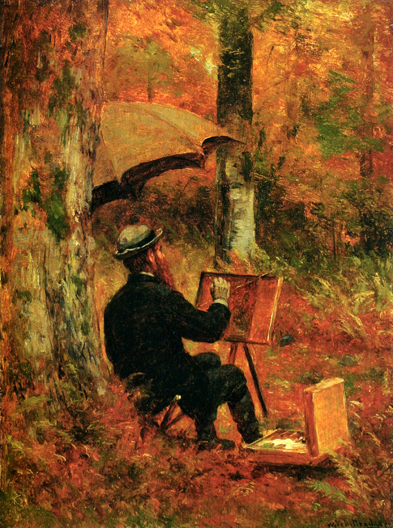
Hudson River School
1820 - 1910

An Artist at his Easel
(Thomas Worthington Whittredge)
Hudson River School
They were a group of American landscape painters of the mid-nineteenth century, who took a Romantic approach to depicting the Hudson River Valley, and of the Catskill, Berkshire, and White Mountains, as well as lands further west landscapist: a painter of a view of natural inland scenery and aerial perspective with an expression of space in painting by gradation of color and distinctness.
I went to the woods because I wished to live deliberately,
to front only the facts of life,
and see if I could not learn what it had to teach.
Four seasons fill the measure of the year;
There are four seasons in the mind of man:
He has his lusty Spring, when fancy clear
Takes in all beauty with an easy span:
He has his Summer, when luxuriously
Spring's honey'd cud of youthful thought he loves
To ruminate, and by such dreaming high
Is nearest unto heaven: quiet coves
His soul has in its Autumn, when his wings
He furleth close; contented so to look
On mists in idleness- to let fair things
Pass by unheeded as a threshold brook.
He has his Winter too of pale misfeature,
Or else he would forego his mortal nature.
YES, it was the mountain Echo,
Solitary, clear, profound,
Answering to the shouting Cuckoo,
Giving to her sound for sound!
Unsolicited reply
To a babbling wanderer sent;
Like her ordinary cry,
Like--but oh, how different!
Hears not also mortal Life?
Hear not we, unthinking Creatures!
Slaves of folly, love, or strife--
Voices of two different natures?
Have not 'we' too?--yes, we have
Answers, and we know not whence;
Echoes from beyond the grave,
Recognised intelligence!
Such rebounds our inward ear
Catches sometimes from afar--
Listen, ponder, hold them dear;
For the God --of God they are.
Thomas Worthington Whittredge (May 22, 1820 - February 25, 1910) was an American artist of the Hudson River School. Whittredge was a highly regarded artist of his time, and was friends with several leading Hudson River School artists including Albert Bierstadt and Sanford Robinson Gifford. He traveled widely and excelled at landscape painting, many examples of which are now in major museums. He served as president of the National Academy of Design from 1874 to 1875 and was a member of the selection committees for the 1876 Philadelphia Centennial Exposition and the 1878 Paris Exposition, both important venues for artists of the day.
Whittredge was born in a log cabin near Springfield, Ohio in 1820. He painted landscapes and portraits as a young man in Cincinnati before traveling to Europe in 1849 to further his artistic training. Arriving in Germany he settled at the Düsseldorf Academy, a major art school of the period, and studied with Emanuel Leutze. At Düsseldorf, Whittredge befriended Bierstadt and posed for Leutze as both George Washington and a steersman in Leutze's famous painting 'Washington Crossing the Delaware', now in the collection of the Metropolitan Museum of Art in New York City.
Emanuel Leutze: 1856
by Thomas Worthington Whittredge
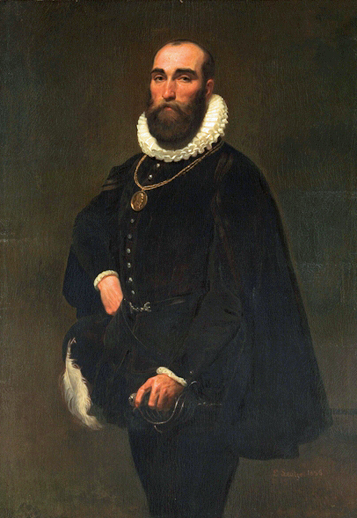
Washington Crossing the Delaware
by Emanuel Leutze
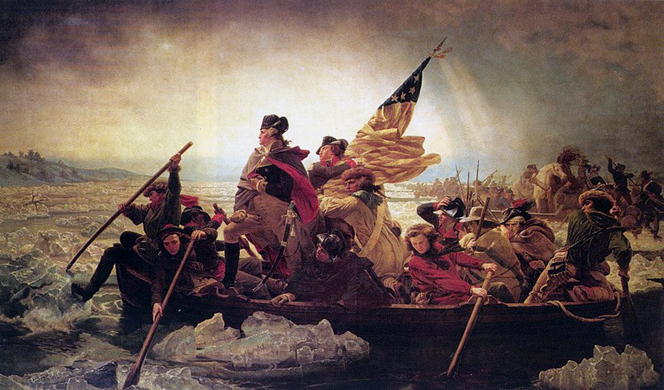
Emanuel Gottlieb Leutze was born in Germany. He studied art in Philadelphia, and in 1859 he moved to New York to live. He became famous for his paintings of American historical scenes.
He painted 'Washington Crossing the Delaware', in Germany and used the Rhine River as his model for the Delaware River. He had visited America many times and had studied paintings of Washington and had looked at his uniform in the museum.
Other famous people crossed the river that night. Among them were James Madison and James Monroe. James Monroe is the man in the boat who is holding the flag. However, that particular design, the Betsy Ross flag with 13 stars and 13 stripes was actually created six months later according to the account at American Revolution.org.
Whittredge spent nearly ten years in Europe, meeting and travelling with other important artists including Sanford Gifford. He returned to the United States in 1859 and settled in New York City where he launched his career as a landscape artist painting in the Hudson River School style.
Whittredge journeyed across the Great Plains to the Rocky Mountains in 1865 with Sanford Gifford and John Frederick Kensett. The trip resulted in some of Whittredge's most important works-unusually oblong, spare landscapes that captured the stark beauty and linear horizon of the Plains. Whittredge later wrote in his autobiography, "I had never seen the plains or anything like them. They impressed me deeply. I cared more for them than for the mountains... Whoever crossed the plains at that period, not withstanding its herds of buffalo and flocks of antelope, its wild horses, deer and fleet rabbits, could hardly fail to be impressed with its vastness and silence and the appearance everywhere of an innocent, primitive existence."
Whittredge moved to Summit, New Jersey, in 1880 where he continued to paint for the rest of his life. He died in 1910 at the age of 89 and is buried in the Springfield, New Jersey cemetery. Whittredge's paintings are now in the collections of numerous museums, including the Metropolitan Museum of Art in New York City and the Smithsonian American Art Museum in Washington, DC.
Various Works of Thomas Worthington Whittredge
(There is no intentional chronological or thematic order to these paitings except for where they were painted.)
Landscape Near Rome: 1858
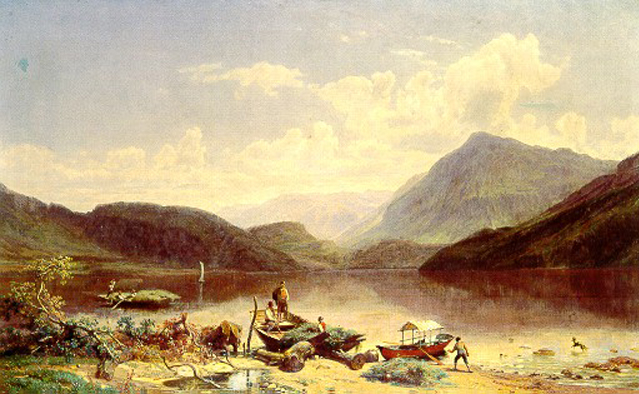
Landscape Near Rome, 1858
In 1849 Worthington Whittredge left Cincinnati, where he and William Sonntag had established a distinctive regional variant of the Hudson River school, for Europe. His avowed intention, unusual among American landscapists, was to find a teacher. Like many artists from the Midwest, he was essentially self-taught. Finding Paris too expensive and not being impressed by the Barbizon Painters, he soon journeyed to Dusseldorf, where he remained for nearly seven years. In the autumn of 1856, after spending the summer sketching in Switzerland, he settled in Rome with Sanford R. Gifford and Albert Bierstadt. Although his friends left the following summer, Whittredge remained in Rome another two years. Whereas he had been well armed with commissions from Cincinnati patrons while in Germany, he was forced to turn to the open market in Rome. As he wrote in his autobiography: "The necessity of selling our work made us bestir ourselves in society, and in making the acquaintance of all the strangers we could, who had come to town." In this he seems to have been successful enough, for he was able to survive in reasonable comfort in a city legendary as one of the cheapest in all of Europe.
The works he painted for the tourist trade fall into two broad classes: Swiss scenes, mainly of Lake Lucerne, and standard picturesque views of the Roman Campagna. The Butler Institute painting, however, partakes of both. Long called 'Landscape Near Rome', it was executed when he spent the summer around Lake Albano and in the Sabine mountains. A slightly smaller variant, with different figures in the foreground, was called 'View of Lake Albano' when it passed through auction in 1984. Nevertheless, the landscape does not look like the scenery to the south and east of Rome. If the artist intended to show that area, then he has transformed it completely to conform to his Swiss scenes, so that the Setting suggests instead a view in the alpine region of northern Italy. The figures, which are standard in Whittredge's European canvases, add a picturesque note. Their costumes further indicate that the locale may be northern Italy, as do the boats, which are indigenous to that area. This, interestingly enough, agrees with the views of the donor, who also regarded it as "probably of a lake in the Italian alps." The painting is similar in composition and style to Whittredge's pictures of Switzerland. Like them, it is horizontal in format, and keeps the mountains at a safe remove. He noted in his autobiography, "I never got into the way of measuring all grandeur in a perpendicular line .... " And like them, it is painted in the academic manner he had absorbed from Carl Friedrich Lessing, Andreas Achenbach, and Johann Schirmer in Dusseldorf, which had much in common with that of the Swiss school led by Francois Diday. It differs, however, in the darker tonality and freer execution. The artist must have regarded the canvas as especially successful, since, as noted above, he repeated it at least once, something that is quite rare in his oeuvre.
Roman Campagna: 1857
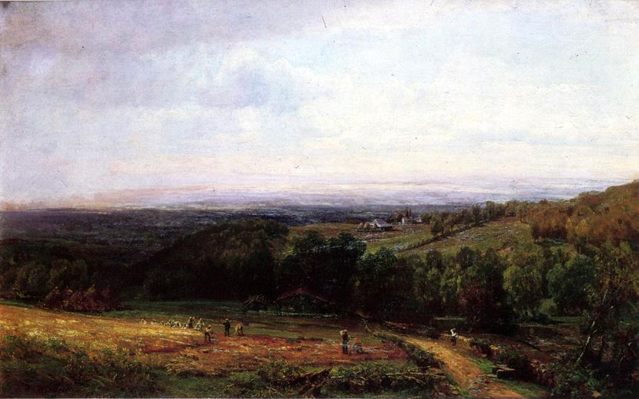
Market at Subiaco: 1856

Travelers in the Swiss Alps: 1857
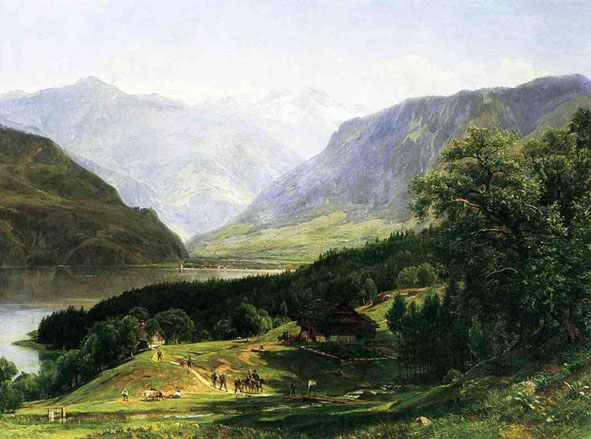
Sunrise on the Wetterhorn: 1858
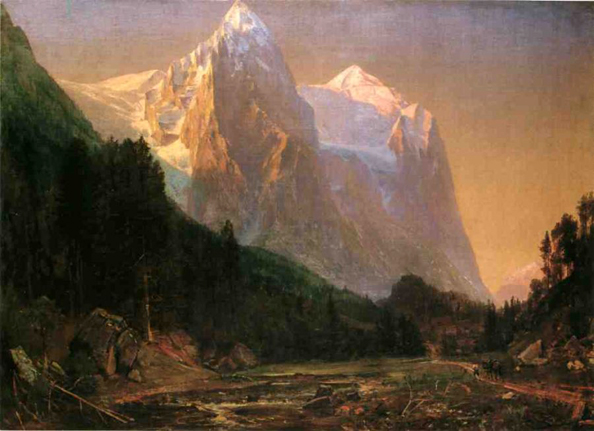
'Sunrise on the Wetterhorn', was painted in Rome in 1858. Most of the Hudson River School painters spent considerable time traveling in Europe as did Albert Bierstadt who depicted the Alps many times around the same time as Whittredge. Both Whittredge and Bierstadt would become famous for their scenes of the American West, although they also would paint many "Hudson River School" works. This very dramatic view of the precipitous Wetterhorn is considered one of his best paintings.
Landscape in Westphalia: 1853

Interior of a Westphalian Cottage: 1852
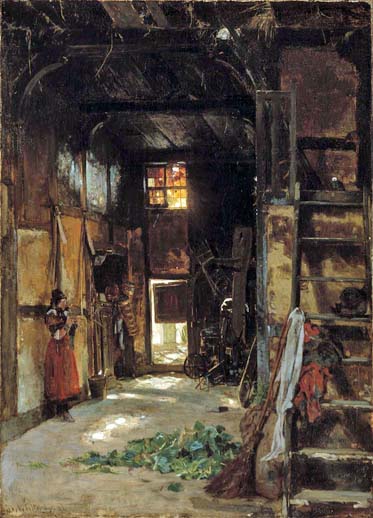
Landscape near Minden: 1855
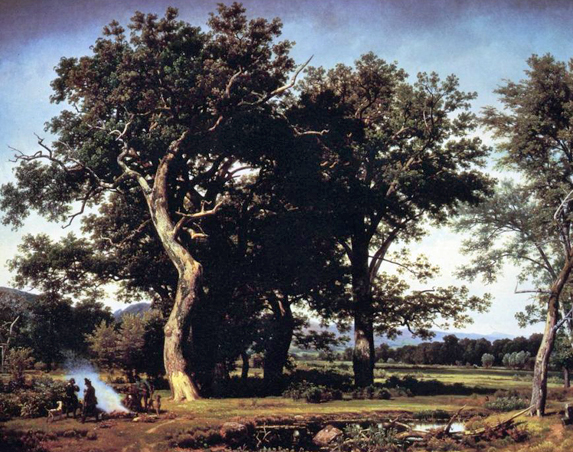
A Sheep Cote on Lake Albano: 1859
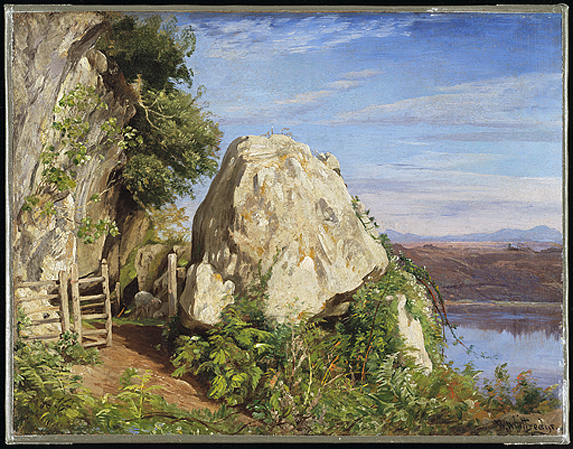
The Amphitheatre of Tusculum and Albano Mountains, Rome: 1860
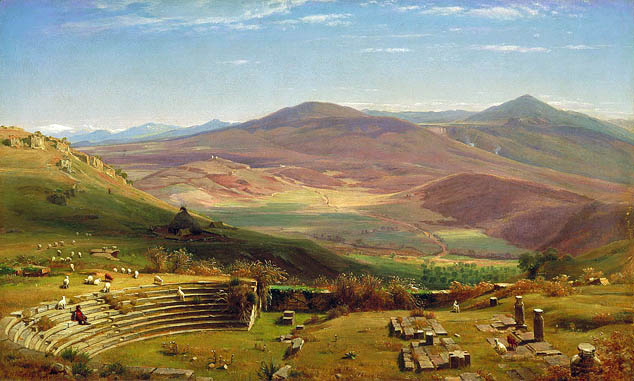
Worthington Whittredge was among many American artists who traveled to Europe in the nineteenth century. The ancient culture of Italy offered a poignant tale of faded glory that contrasted sharply with America's rise to economic and political power. Whittredge showed the ruins of the amphitheatre at Tusculum in the harsh light of day. Indolent shepherds nod off and goats graze where Rome's actors and playwrights once took their bows. A thatched hut and meager yard appear in the shadow of a cloud, signifying the poverty that struck American travelers as powerfully as the magnificent ruins
The United States stood on the threshold of the Gilded Age, when public art and architecture would follow the model of ancient Rome and Greece. But Italy's most important contribution to America would be its people, who immigrated to the United States by the hundreds of thousands, contributing their labor and culture to the nation's coming-of-age.
View near Lake Lucerne: 1857
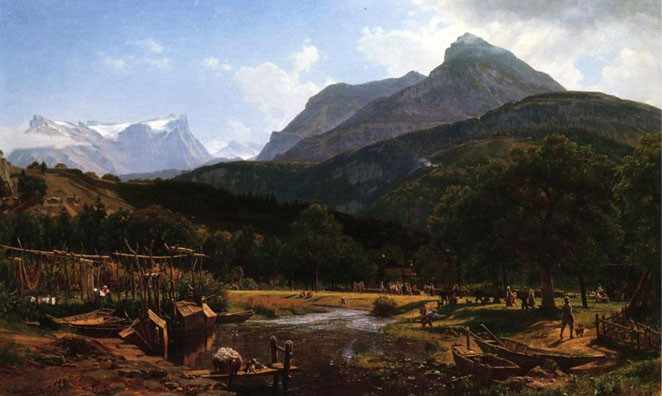
The Bay of Uri, Lake Lucerne: 1859

A Catskill Brook: 1875
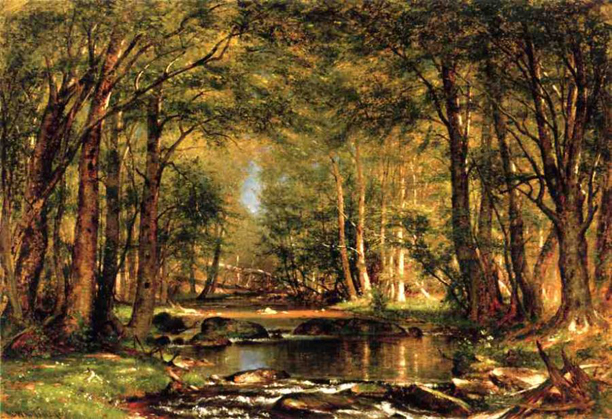
A Catskill Brook: Date Unknown
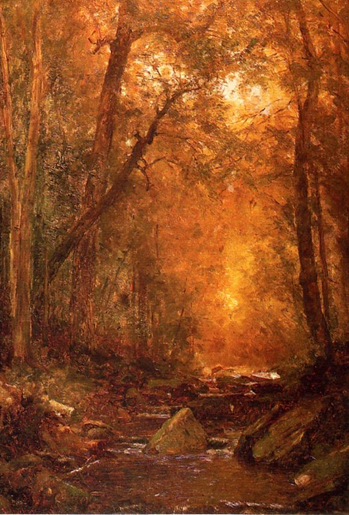
A Fisherman's Windlass, Sketch on the Hudson: Date Unknown

A Home by the Seaside: ca 1872
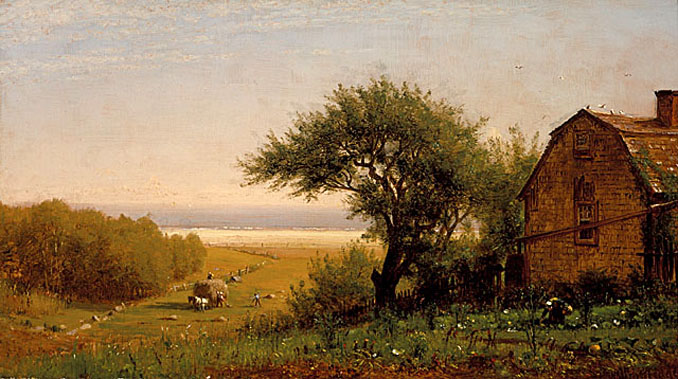
The location of this landscape has been identified as Newport, Rhode Island. Whittredge may have first visited the area as early as 1859, immediately following his return to America. He visited it often and even built a summer house there. He became fascinated with the colonial architecture of the area, drawing and painting Bishop George Berkeley's house, Whitehall. Whittredge's first Newport painting dates from 1865, and in the early 1870's he began a series of Newport landscapes in which the focus was a shingled, gambrel-roofed farmhouse near the sea. In most of these landscapes, such as 'Home by the Sea', ca. 1872, and 'Old Homestead by the Sea', 1883, the artist assumed an elevated position away from the house to obtain an expansive view of the surrounding countryside and distant ocean.
'A Home by the Seaside' is the only painting in this series in which Whittredge moved closer to the house, which serves as a framing device leading the viewer into the scene and down the hill to the field below where men are working. The image of hayers was a popular motif, frequently used by Whittredge and other artists of the period to convey the nationalistic pride of a country rich in natural resources and human energy. Although Whittredge explained his attraction to Newport as returning to the land of his forefathers, a land made familiar to him through tales heard as a child, his fascination was also part of a general cultural trend during the late nineteenth century called the colonial revival. The farmhouse in 'A Home by the Seaside' has not been specifically identified, but its type and age added a note of native picturesqueness to the scene. Whittredge did not depict Newport as the fashionable summer resort of the elite but as the land he had heard about as a child. The soft autumnal haze contributes to the general sentiment of nostalgia.
By the 1870's Whittredge had become known for his serene, sun-filled, open landscapes. When this painting was exhibited, such critics as George Sheldon praised its diffused light and quiet mood.
A Home on the Hudson: 1862

A Hunter in a Landscape: 1860
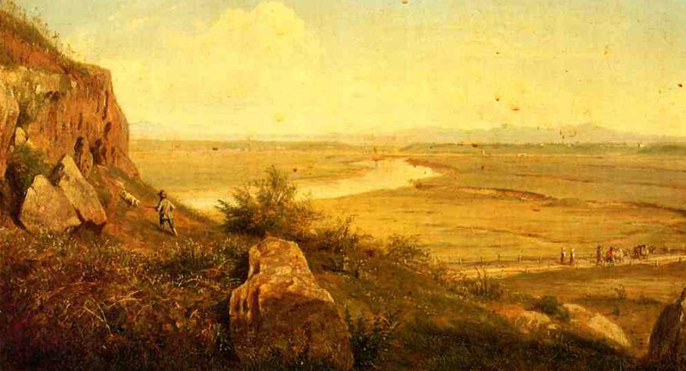
A Mexican Fountain, City of Orizaba: 1903
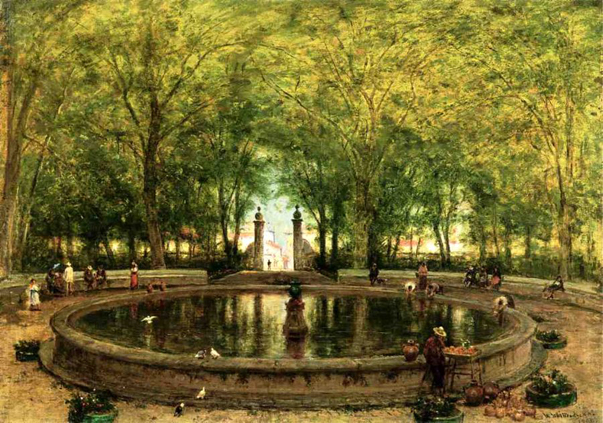
A New Land: Unknown Date
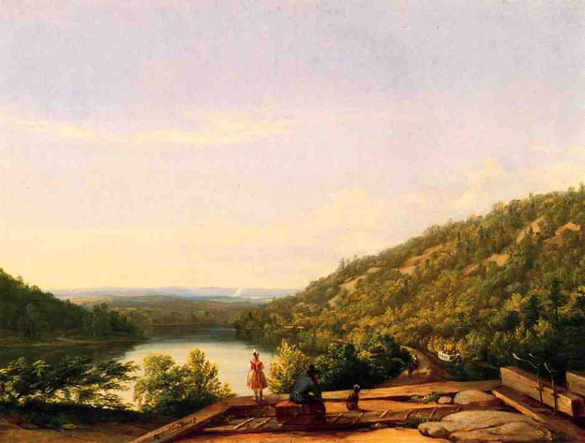
A Window - House on the Hudson River: 1863
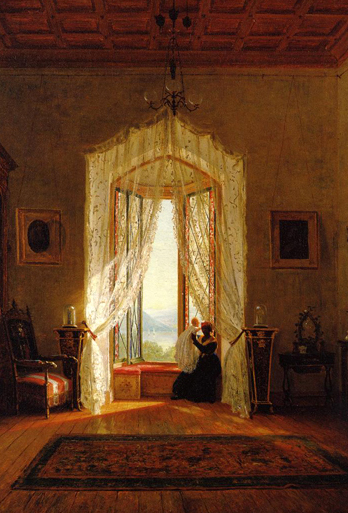
An African-American nurse sits on the window seat in an elegantly furnished home holding a white baby in an elaborate outfit, possibly a christening dress. Light streams in from the window, blazing a path through the dim interior. Outside is a crystalline view of the Hudson River.
The nurse would have been an emancipated worker, since slavery had by this time been abolished in New York. The baby's outfit appears to be a christening dress and the open window in the background is a traditional symbol of hope. Whittredge was primarily a landscape painter and his genre scenes often included through-the-window landscapes. The setting for this painting is believed to be the Louisa Nevins residence in Riverside, New York.
Retrospection: 1864
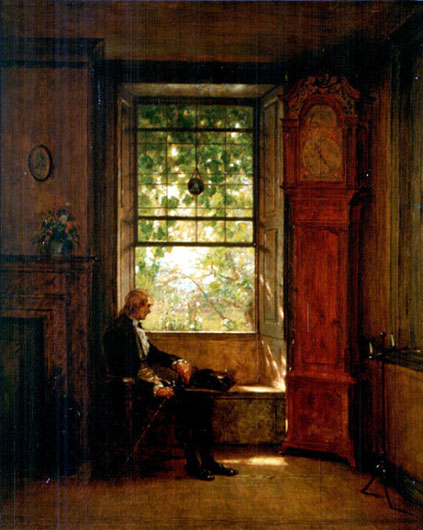
Adirondack Woodland with Two Deer: 1880
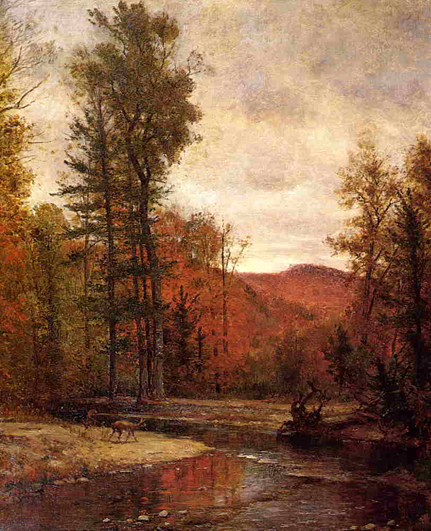
Albert Gallatin

Thomas Worthington Whittredge was commissioned to paint a portrait of Albert Gallatin.
Abraham Alfonse Albert Gallatin was a Swiss-American ethnologist, linguist, politician, diplomat, Congressman, and the longest-serving United States Secretary of the Treasury. He was also a founder of New York University.
Born in Switzerland, Gallatin immigrated to America in the 1780's, ultimately settling in Pennsylvania. He was politically active against the Federalist Party program, and was elected to the United States Senate in 1793, but was removed from office by a 14-12 party-line vote after a protest raised by his opponents suggested he had fewer than the required nine years of citizenship. In 1795 he was elected to the House of Representatives and served in the fourth through sixth Congresses, becoming House Majority Leader. He was an important leader of the new Democratic-Republican Party, and its chief spokesman on financial matters and opposed the entire program of Alexander Hamilton. He also helped found the House Committee on Finance (later the Ways and Means Committee) and often engineered withholding of finances by the House as a method of overriding executive actions to which he objected. While Treasury Secretary, his services to his country were honored in 1805 when Meriwether Lewis named one of the three headwaters of the Missouri River after Gallatin.
Autumn Landscape, Vermont: 1874
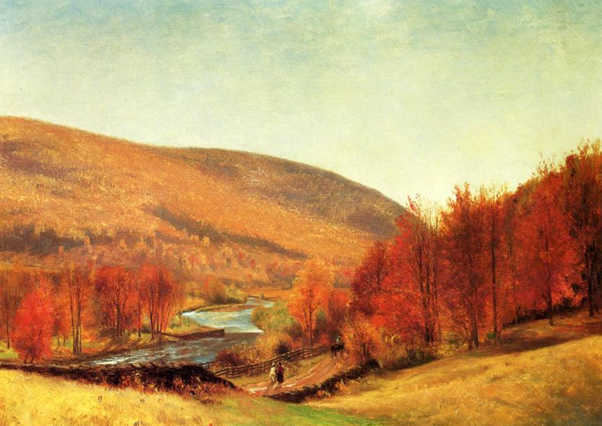
Autumn on the Delaware: 1875
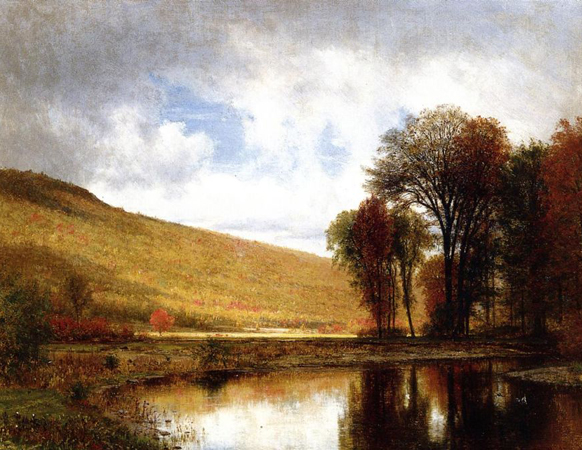
Autumn on the Hudson: 1875

Ode to Autumn
by John Keats
Season of mists and mellow fruitfulness,
Close bosom-friend of the maturing sun;
Conspiring with him how to load and bless
With fruit the vines that round the thatch-eves run;
To bend with apples the moss'd cottage-trees,
And fill all fruit with ripeness to the core;
To swell the gourd, and plump the hazel shells
With a sweet kernel; to set budding more,
And still more, later flowers for the bees,
Until they think warm days will never cease,
For Summer has o'er-brimm'd their clammy cells.
Who hath not seen thee oft amid thy store?
Sometimes whoever seeks abroad may find
Thee sitting careless on a granary floor,
Thy hair soft-lifted by the winnowing wind;
Or on a half-reap'd furrow sound asleep,
Drows'd with the fume of poppies, while thy hook
Spares the next swath and all its twined flowers:
And sometimes like a gleaner thou dost keep
Steady thy laden head across a brook;
Or by a cyder-press, with patient look,
Thou watchest the last oozings hours by hours.
Where are the songs of Spring? Ay, where are they?
Think not of them, thou hast thy music too,--
While barred clouds bloom the soft-dying day,
And touch the stubble-plains with rosy hue;
Then in a wailful choir the small gnats mourn
Among the river sallows, borne aloft
Or sinking as the light wind lives or dies;
And full-grown lambs loud bleat from hilly bourn;
Hedge-crickets sing; and now with treble soft
The red-breast whistles from a garden-croft;
And gathering swallows twitter in the skies.
Along the Delaware
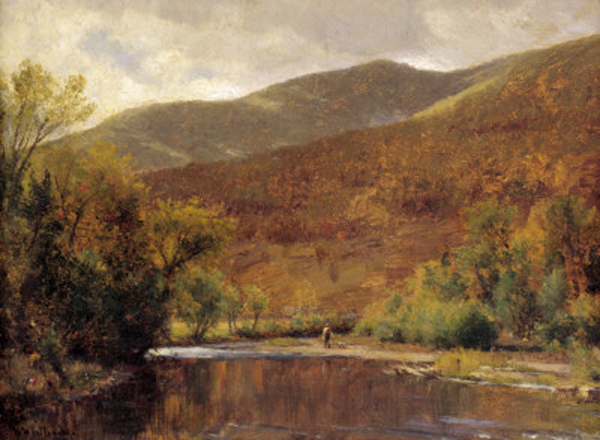
In the 1870's Whittredge often painted along the picturesque banks of the upper Delaware River in the northeast corner of Pennsylvania. In this autumn view, the small figures of a man and dog are immersed in nature between the hillside above and the reflective lake below. The water unites sky and ground and adds a measure of stillness to the painting's tranquil mood. The presence of water in nineteenth-century landscapes, with its qualities of purity and transparency, enhanced the concept of nature as a spiritual refuge.
Beach scene, Narragansett Bay: 1880

Along the Delaware

In the 1870's Whittredge often painted along the picturesque banks of the upper Delaware River in the northeast corner of Pennsylvania. In this autumn view, the small figures of a man and dog are immersed in nature between the hillside above and the reflective lake below. The water unites sky and ground and adds a measure of stillness to the painting's tranquil mood. The presence of water in nineteenth-century landscapes, with its qualities of purity and transparency, enhanced the concept of nature as a spiritual refuge.
Beach at Newport: ca 1860
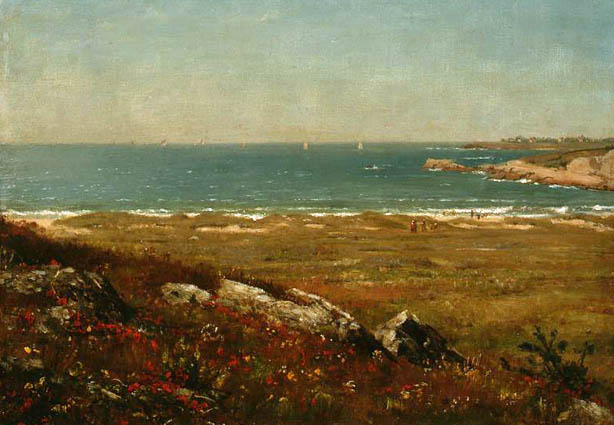
As it happens again and again in the history of art, there has been a re-evaluation of the work of Worthington Whittredge; he is now deemed an important nineteenth century painter. There is little in 'Beach at Newport' to suggest Whittredge's Düsseldorf training. Unlike the German school the painting is less conventional in composition and, indeed, creates a sense of vastness that belies its modest size. With its lightened palette and touches of color, 'Beach at Newport' approaches the freshness of early Impressionism. On the original stretcher of the painting is written "Southfield Near Stamford." Southfield has long been known as the beach area in Stamford, Connecticut, and is highly likely that this was the site of the painting rather than Newport, Rhode Island.
Bishop Berkeleys Seat, Newport, Rhode Island: 1878
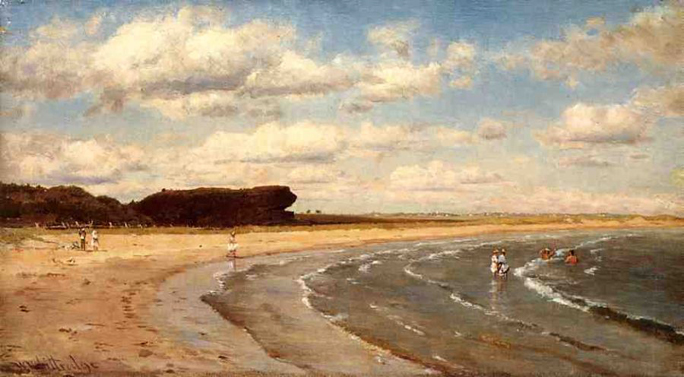
By the Sea Newport, Rhode Island
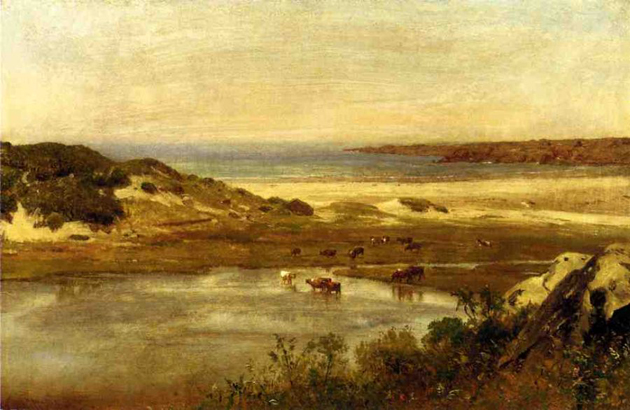
Crow's Nest: 1848
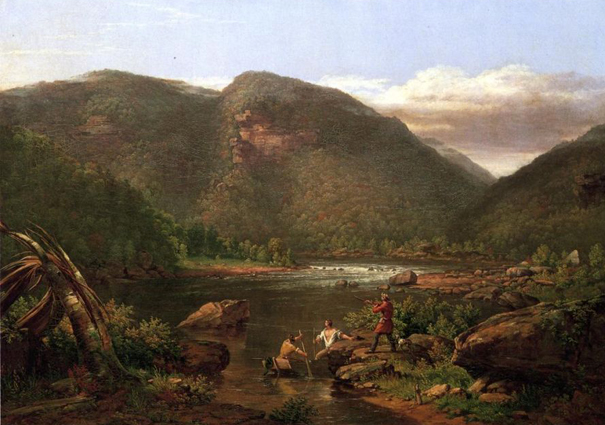
Deer by a Waterfall: 1850
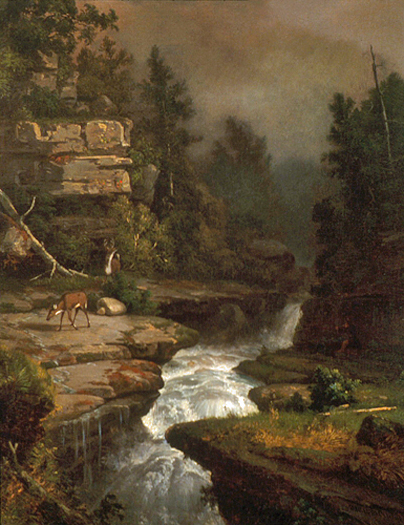
Deer in an Autumn Landscape: 1876
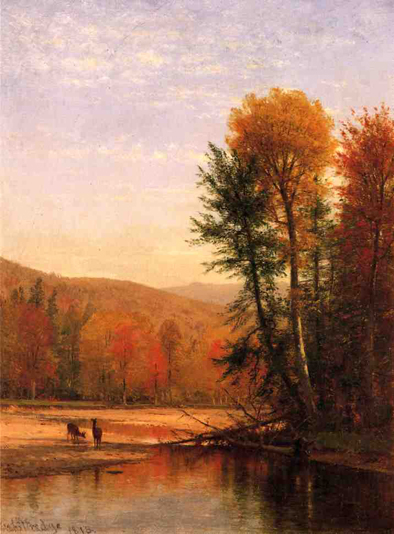
Deer Watering: ca 1975
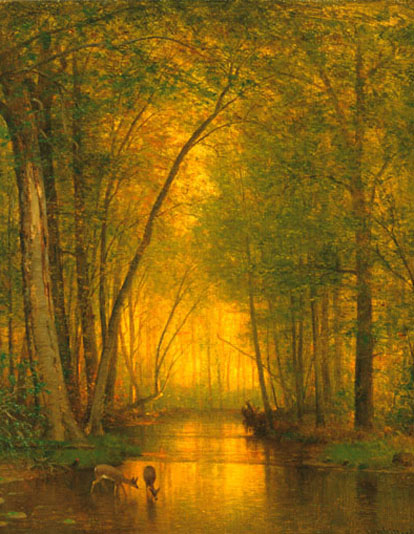
Duck Pond: 1864

Fallen Birch: 1881
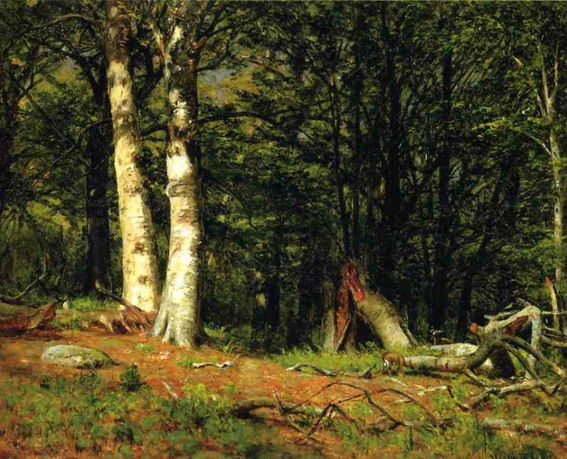
Birch Trees: ca 1872
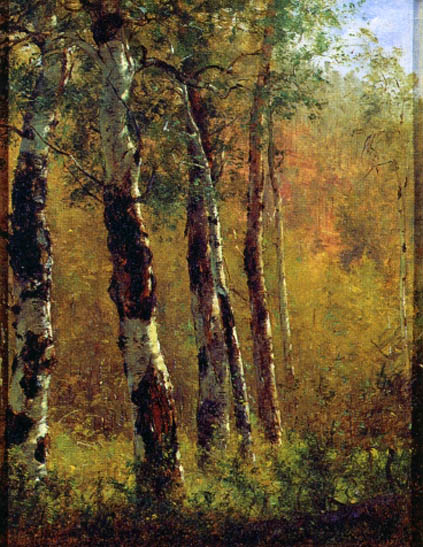
The Birches of the Catskills: ca 1875

Worthington Whittredge found it difficult to adjust to painting the New England landscape after almost ten years abroad. He described the forests as "a mass of decaying logs and tangled brush wood" that were completely different from the "well-ordered" European views he was used to. The broad brushstrokes of 'The Birches of the Catskills' suggest that Whittredge painted the small canvas on the spot. The disordered view of tall trees, fallen branches, and undergrowth emphasizes the untamed quality that had initially unsettled the artist.
Farm by the Shore: 1881
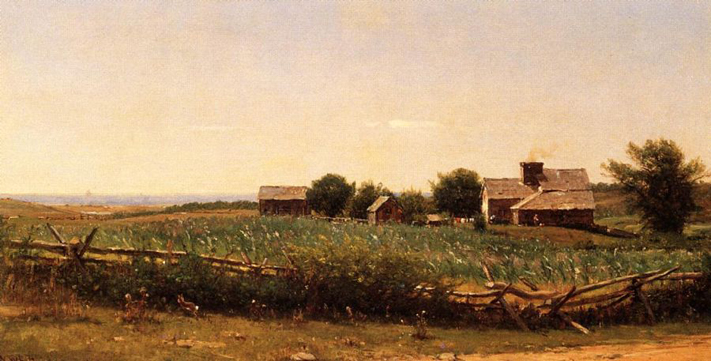
Freshwater Pond in Summer, Rhode Island
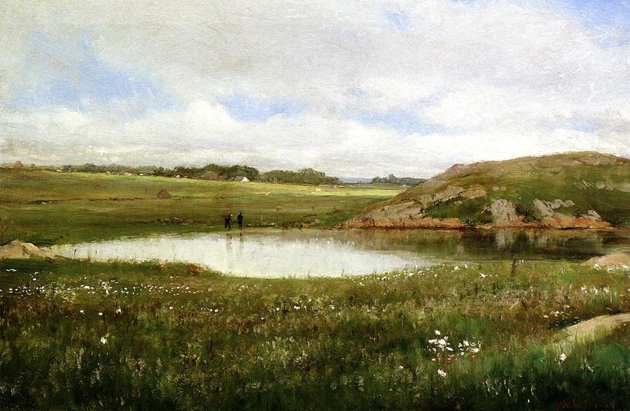
Going to the Village
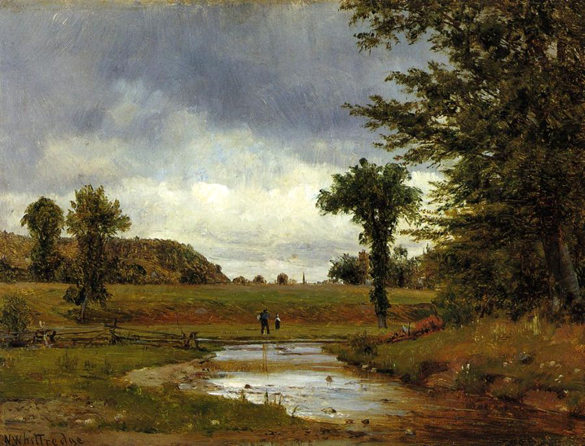
Happy as a King: 1843
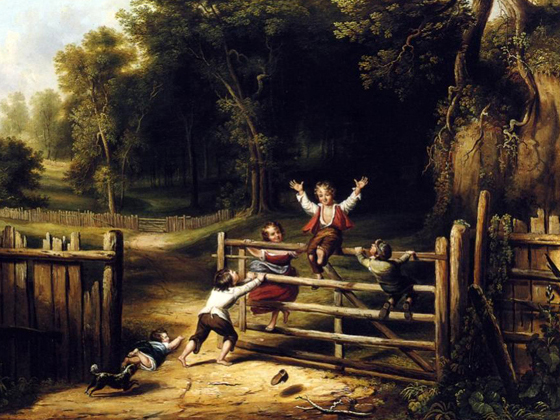
Hemlocks in the Catskills
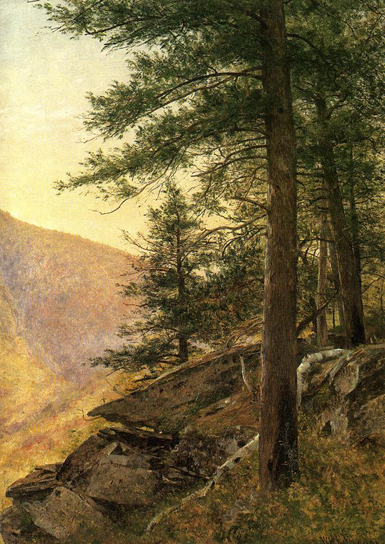
It's hard to describe the feeling of being in an old-growth hemlock forest. The trees are large, up to three feet across, and may be hundreds of years old. The canopy is dense and casts a deep shade, making the air below cool and moist. Because of the deep shade, there are very few saplings or ground plants, and the accumulation of dead needles makes the forest floor springy underfoot. The dark and cool and quiet lends the forest a cathedral-like atmosphere.
House by the Sea: 1872
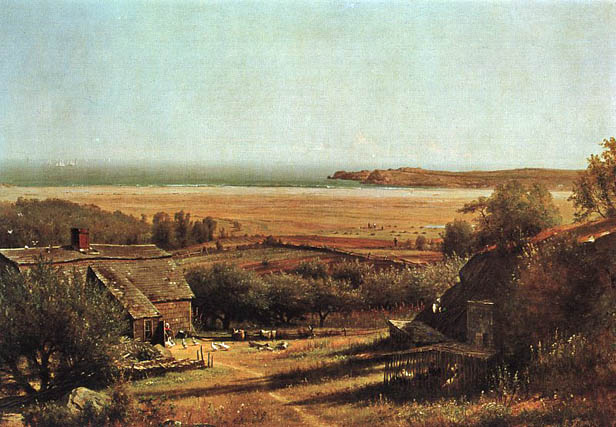
The location of this landscape has been identified as Newport, Rhode Island. Whittredge may have first visited the area as early as 1859, immediately following his return to America. He visited it often and even built a summer house there. He became fascinated with the colonial architecture of the area, drawing and painting Bishop George Berkeley's house, Whitehall. Whittredge's first Newport painting dates from 1865, and in the early 1870's he began a series of Newport landscapes in which the focus was a shingled, gambrel-roofed farmhouse near the sea. In most of these landscapes, such as 'Home by the Sea', ca. 1872, and 'Old Homestead by the Sea', 1883, the artist assumed an elevated position away from the house to obtain an expansive view of the surrounding countryside and distant ocean.
'A Home by the Seaside' is the only painting in this series in which Whittredge moved closer to the house, which serves as a framing device leading the viewer into the scene and down the hill to the field below where men are working. The image of hayers was a popular motif, frequently used by Whittredge and other artists of the period to convey the nationalistic pride of a country rich in natural resources and human energy. Although Whittredge explained his attraction to Newport as returning to the land of his forefathers, a land made familiar to him through tales heard as a child, his fascination was also part of a general cultural trend during the late nineteenth century called the colonial revival. The farmhouse in 'A Home by the Seaside' has not been specifically identified, but its type and age added a note of native picturesqueness to the scene. Whittredge did not depict Newport as the fashionable summer resort of the elite but as the land he had heard about as a child. The soft autumnal haze contributes to the general sentiment of nostalgia.
By the 1870's Whittredge had become known for his serene, sun-filled, open landscapes. When this painting was exhibited, such critics as George Sheldon praised its diffused light and quiet mood.
Hunter in the Woods of Ashokan: 1868
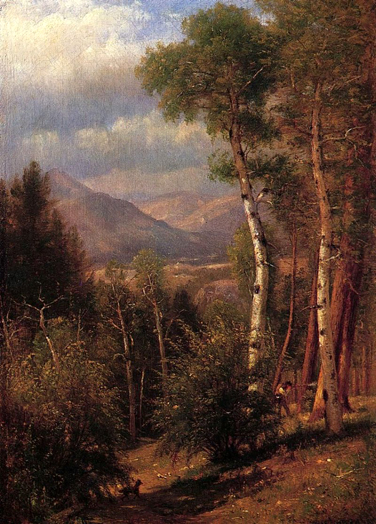
Set in the Catskill Mountains of New York State, this visionary scene of virgin Nature clearly demonstrates Whittredge's debt to Hudson River School painters. The autumnal view and its lighting suggest the course of human life in an elegiac and spiritual mode, a legacy of the artist's early study at the Düsseldorf Academy.
June Paradise Valley
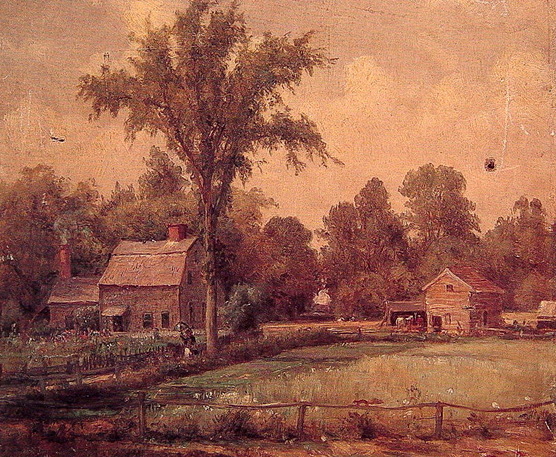
Kauterskill Clove: 1864
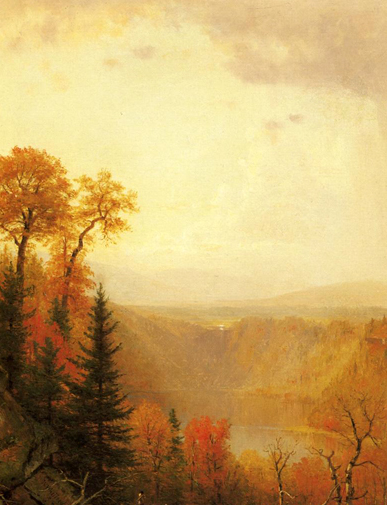
But what many artists did not recognize, especially the school of landscape painters who had risen to prominence in the 1850's was that their position as leaders in the great American dialogue about the visual arts would be altered as well. The so-called Hudson River School painters, so-called by their critics in the years after the Civil War to distinguish them from their younger rivals, produced grand and glorious paintings in the 1860's that were suffused in an all-encompassing twilight. Those setting suns hovering above sublime wilderness settings alluded to the end of the frontier and the frontier experience. But those same twilight subjects by Worthington Whittredge, Sanford Gifford, and others also pointed to the end of an era, they suggested the fleeting nature of human existence, made bitterly obvious by the Civil War, and, inadvertently, they served as eloquent elegies to their own aesthetic in decline -- to the end of their own golden age.
Landscape

Landscape at Sunset: 1902
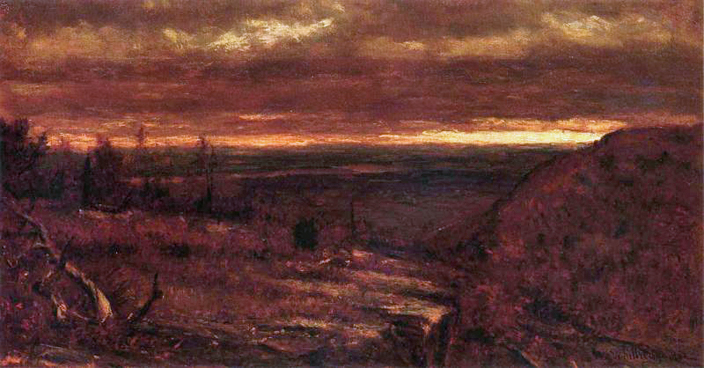
Landscape in the Catskills: Date Unknown
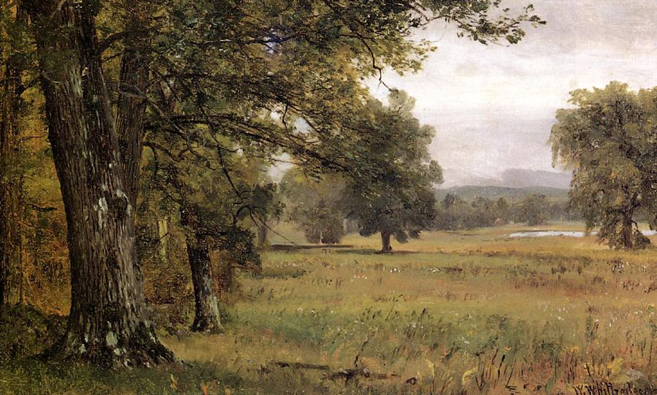
Landscape with River: 1881

Landscape with Stream and Deer: ca 1880
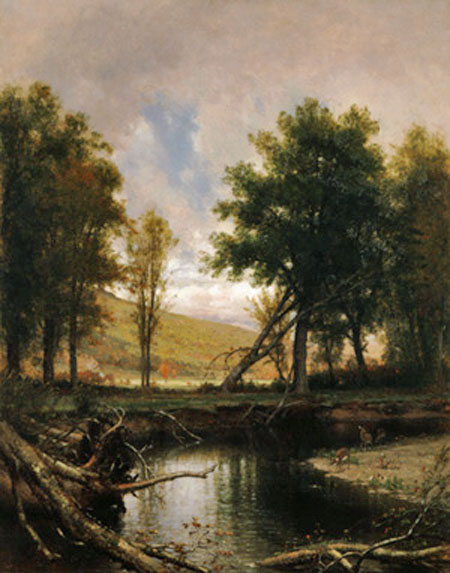
Landscape with Trees and Cattle: 1890
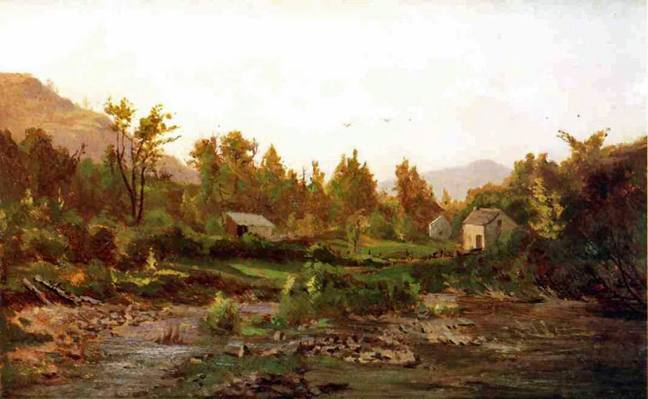
Morning in the Woods: 1868
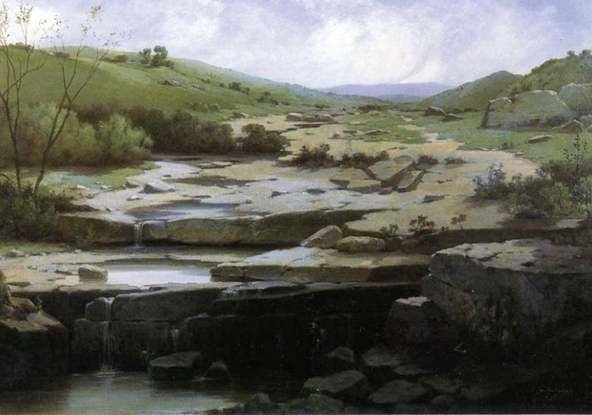
Near Gray Court Junction: 1872
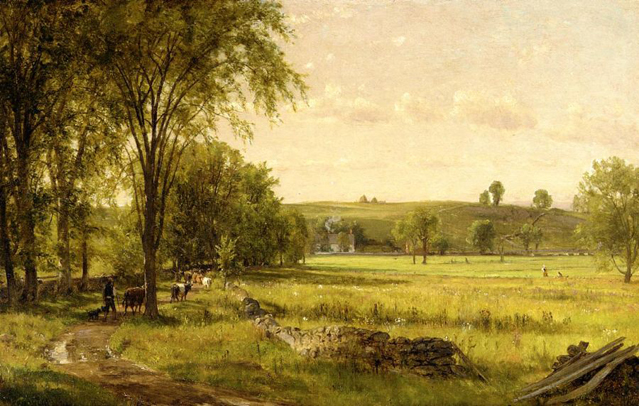
New York Landscape
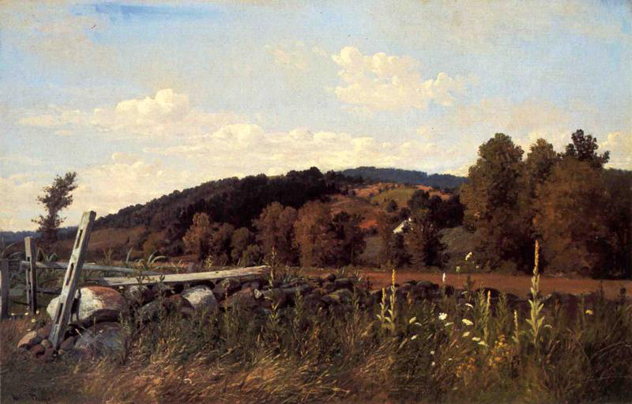
Newport Beach, Rhode Island
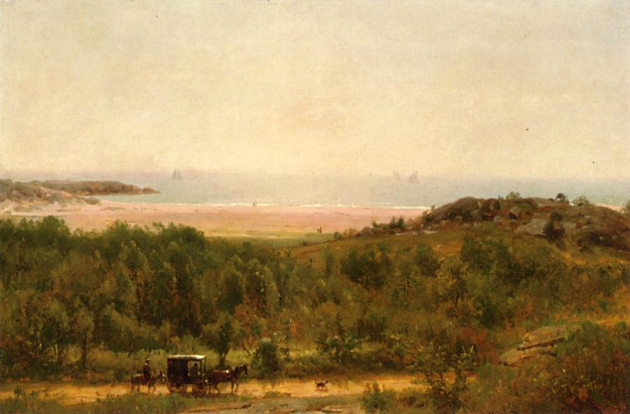
No Water in the Well: 1885
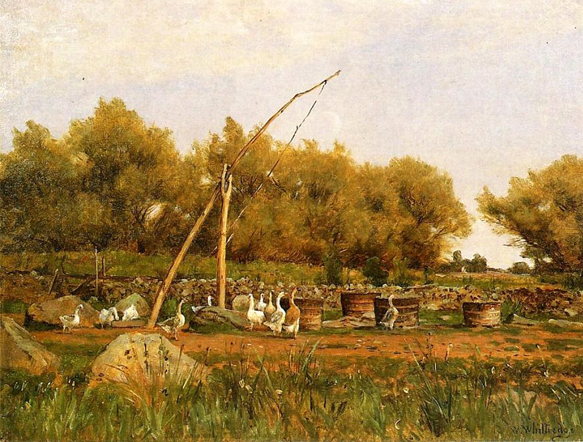
Noon in the Orchard: 1900
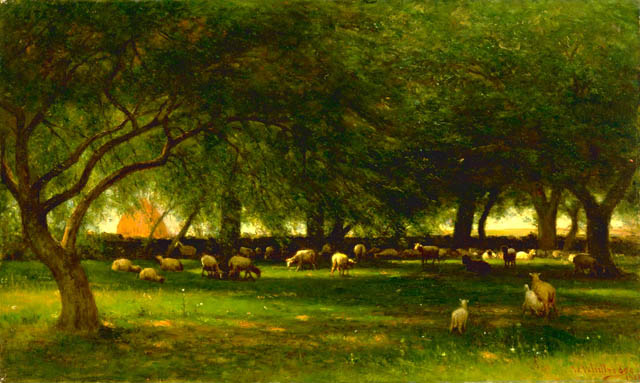
Old House, Westport
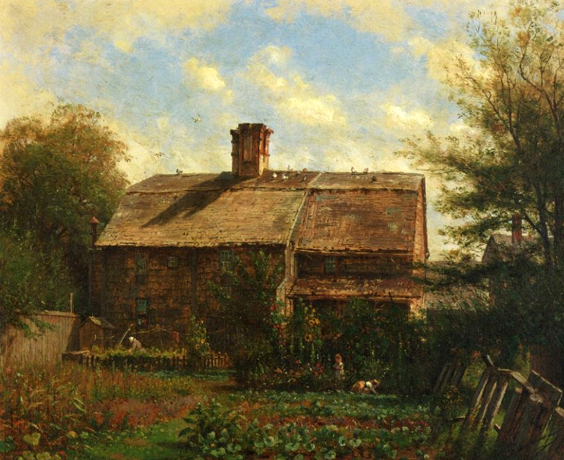
Pool and Heron
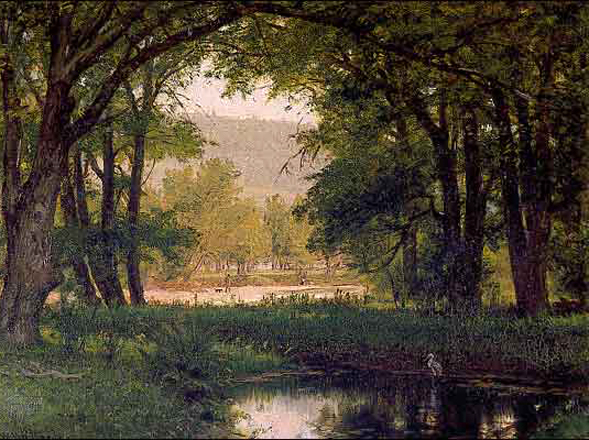
Thomas Worthington Whittredge did not come under the influence of the French Barbizon style until the mid-1870's. The view of an intimate glade surrounded by woods in 'Pool and Heron' was a major departure from the grand vistas of the Hudson River school he had painted during previous decades. In keeping with the Barbizon manner, Whittredge has depicted a quiet place for solitude and contemplation. Typical of Whittredge is his use of trees as a way of framing and separating the shadowy foreground from the open sunlit space in the background. Moreover, he retained the primacy of nature over the human presence advocated by Rousseau; he includes the heron in his title and excludes any mention of the diminutive figure of the hunter barely visible in the background. The finished look of these paintings compared with later landscapes demonstrates they were completed, over time, in the studio.
Rock Ledge and Pond: 1863
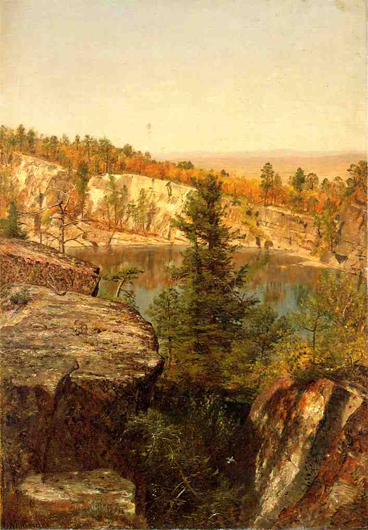
Seascape: 1883
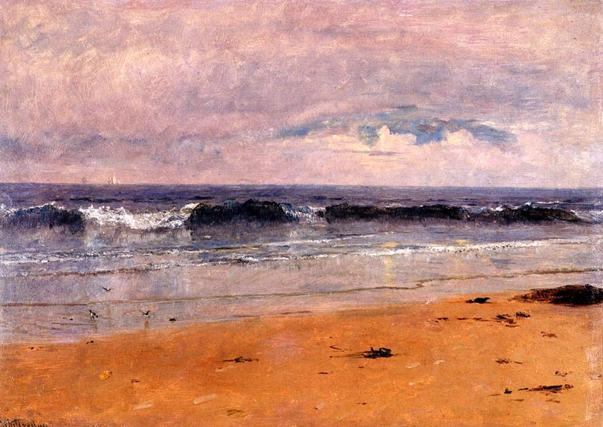
Seaweed Harvest
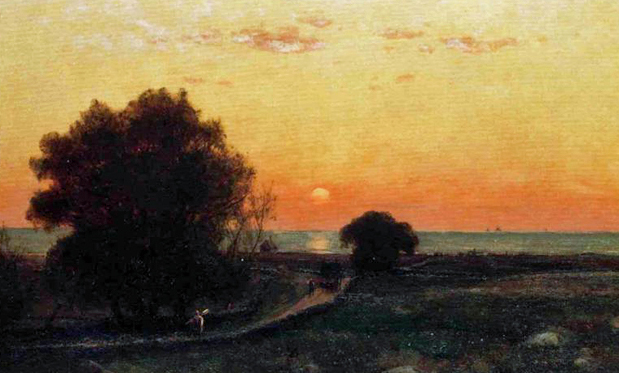
Seconnet Point, Rhode Island: ca 1880
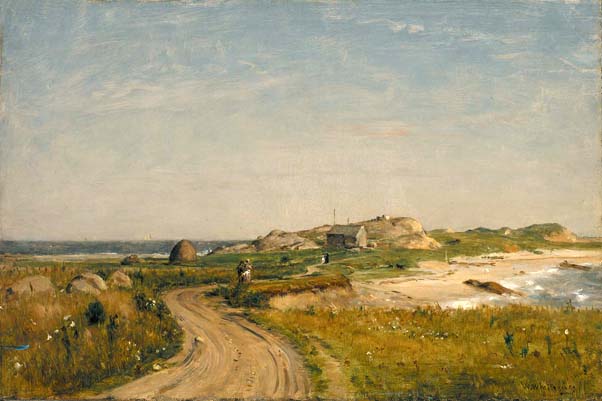
Worthington Whittredge traveled to Newport, Rhode Island, in the fall of 1877. He was inspired by the French painter Charles-François Daubigny. One of the forerunners of impressionism, Daubigny emphasized the effects of light and color on the landscape. In this painting, Whittredge used bright, clean colors and expressive brushstrokes to evoke the fresh atmosphere of a coastal scene. The curved road in the foreground invites us to follow the couple, who are walking through the fields to the deserted beach.
Shawangunk Vista: 1865
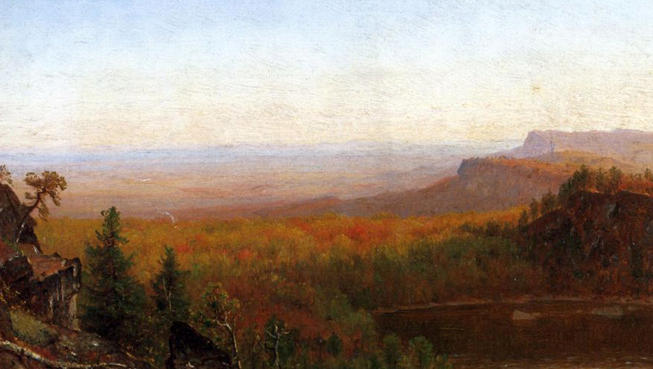
Spring on the River: 1903

Still Life with Peaches: 1876

Study from Nature: 1863

Summer Idle
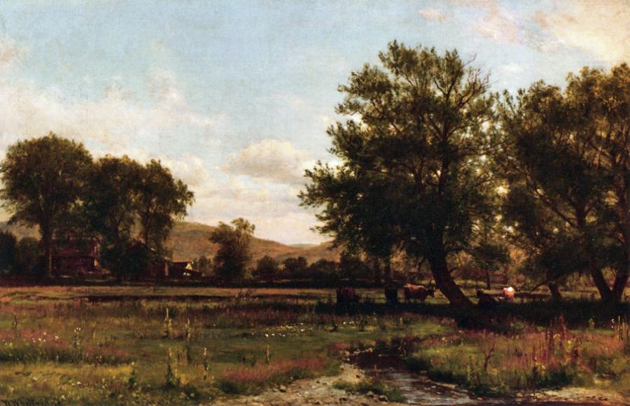
Sunshine on the Brook: 1870
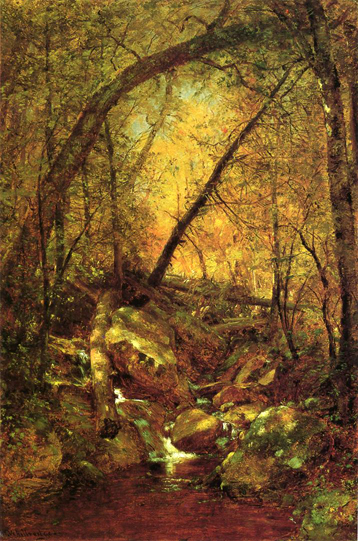
Thatcher's Island
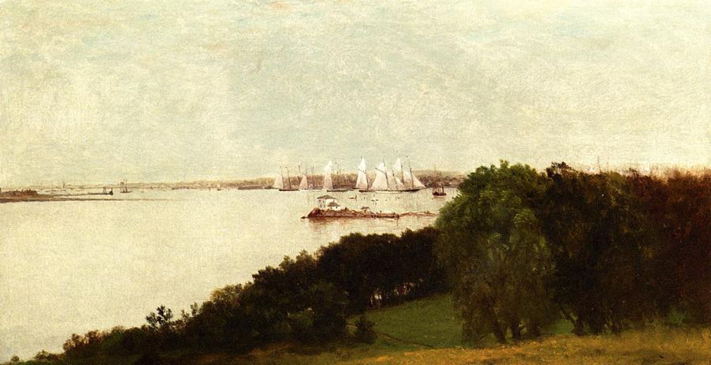
The Camp Meeting
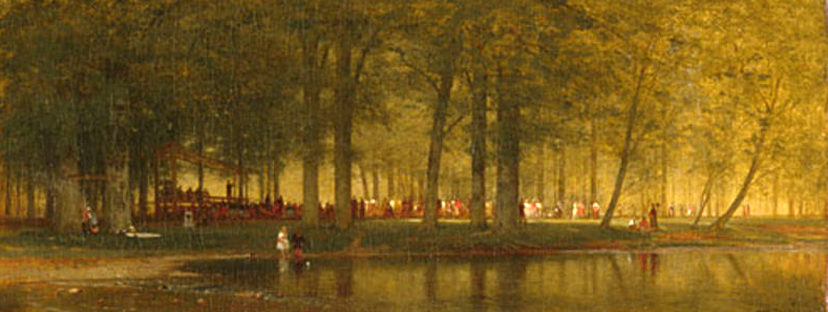
The Club House Sitting Room at Balsam Lake, Catskills: 1886
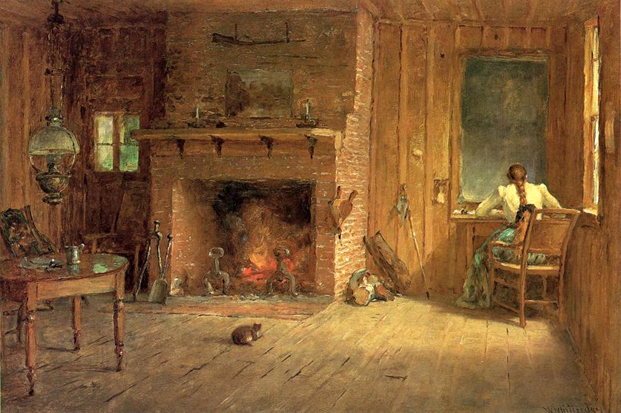
The Meadow
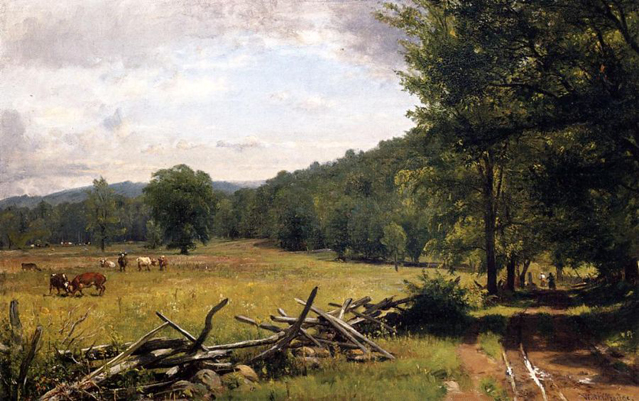
The Mill, Simsbury, Connecticut: 1875
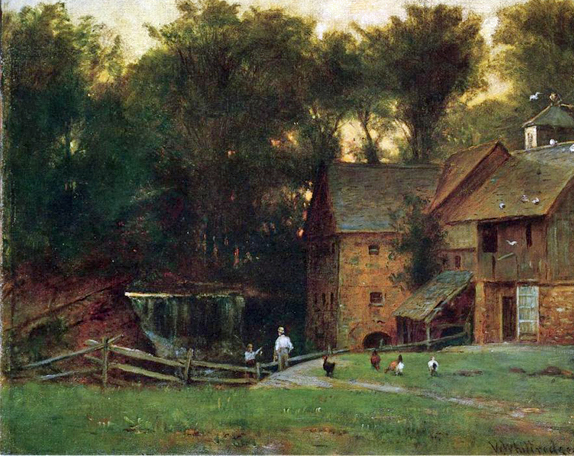
The Morning Stage: 1875
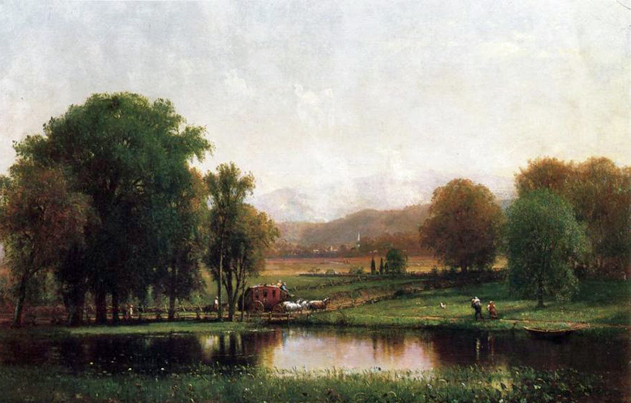
The Old Hunting Ground: 1864
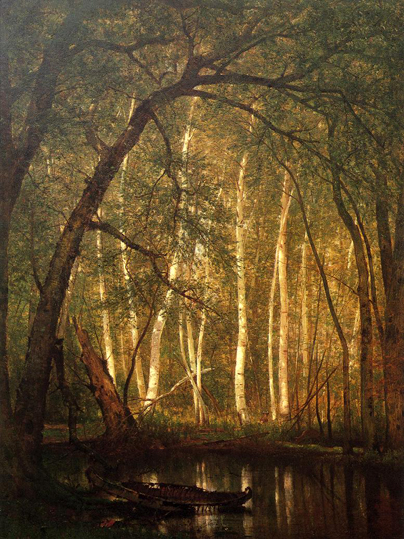
The Old Hunting Grounds brought international fame for Whittredge. Exhibited at the Exposition Universelle in Paris in 1867, the Philadelphia Centennial of 1876, and the Metropolitan Museum of Art in 1880, the painting was revered in its day for capturing the romantic ideal of the cathedral in the wilderness. Inherited by Gifford Pinchot, Secretary of the Interior under Theodore Roosevelt, 'The Old Hunting Grounds' thus passed into the hands of the man responsible for fencing the West. Ironies abound in the notion of this icon of nature hanging in the home of the man who brought order to the last American frontier.
The Old Hunting Ground
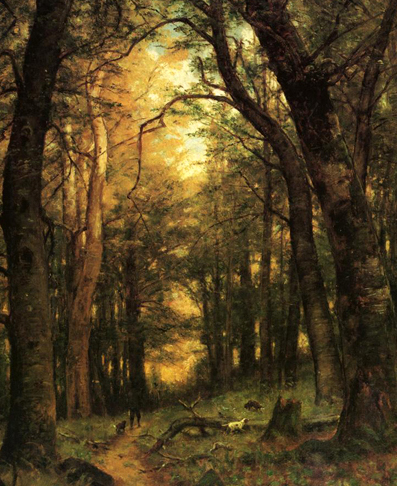
The Old Road to the Sea: 1884
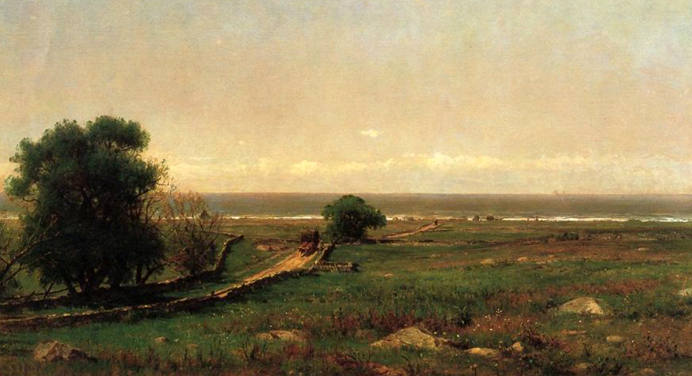
The Pine Cone Gatherers: 1866
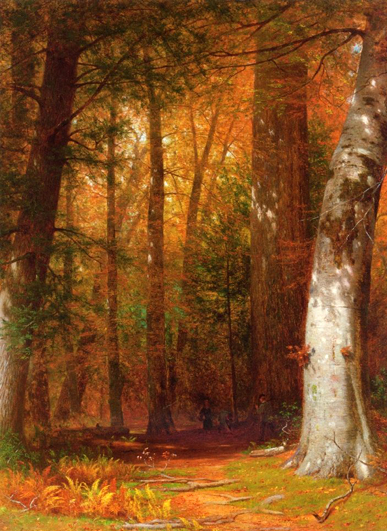
The Rainbow: 1901
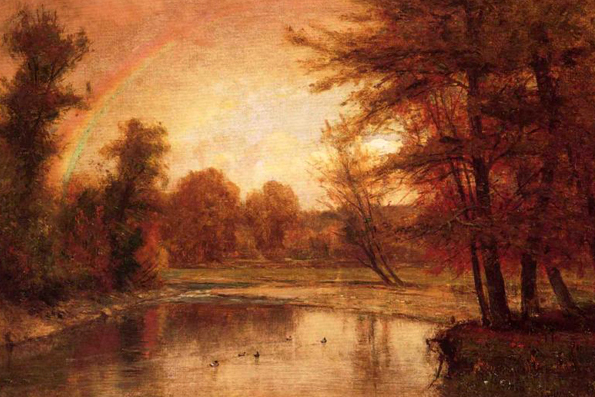
The Sea from the Dove Cote, Newport, Rhode Island: 1880

Peaches: 1894
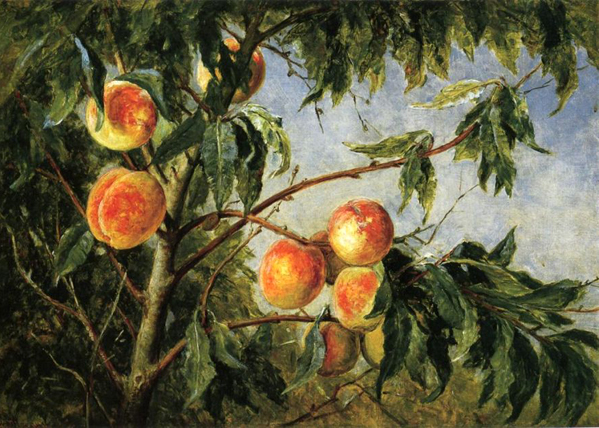
Thomas Worthington Whittredge: ca 1900

Thomas Worthington Whittredge
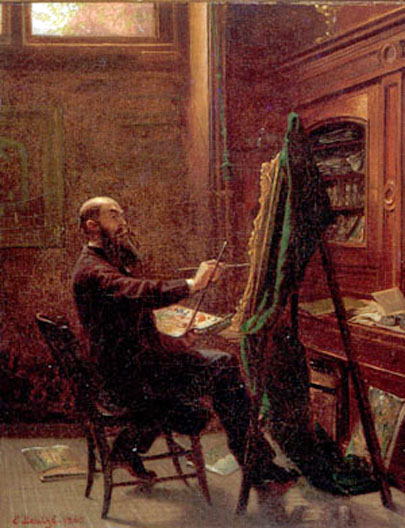
Portrait of Worthington Whittredge
by William Merritt Chase
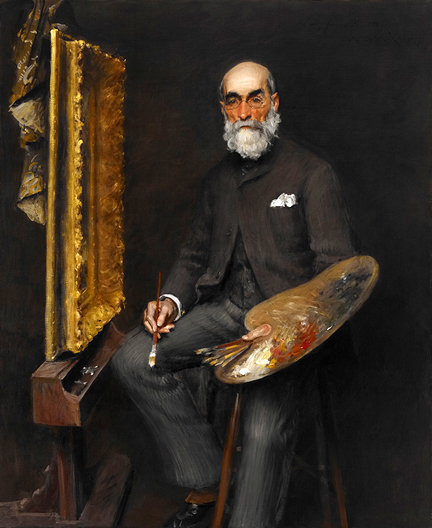
Trout Fishing in the Adirondacks: ca 1862
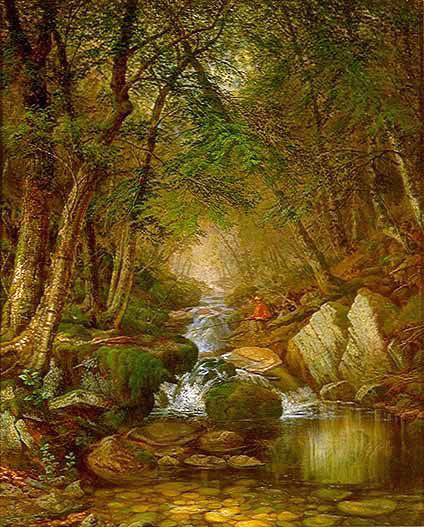
In this intimate scene, we are placed at stream's edge, near a fisherman, as we contemplate the quiet scene. He further enhances this intimate quality by creating cathedral-like arches with the trees so that the scene looks like an intimate nature chapel.
Trout Stream
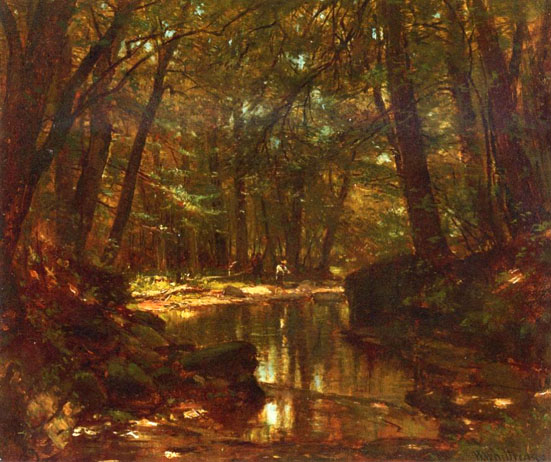
The Trout Pool: 1870

Painted in 1870, eleven years after Whittredge's return from Europe, The Trout Pool exemplifies his mature style and is among his most successful efforts at representing woodland interiors, which were among his favorite subjects.
Twilight in the Shawangunk Mountains: 1865
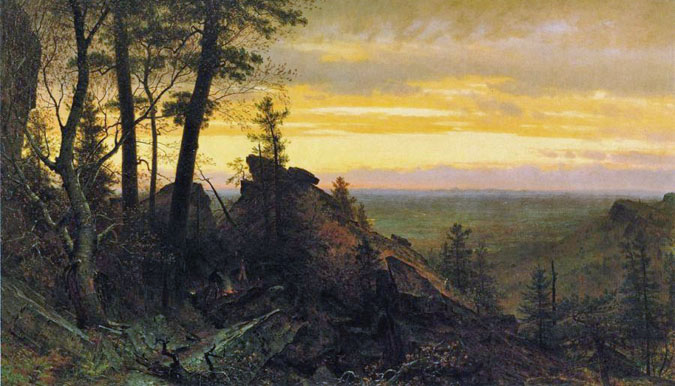
Twilight Landscape
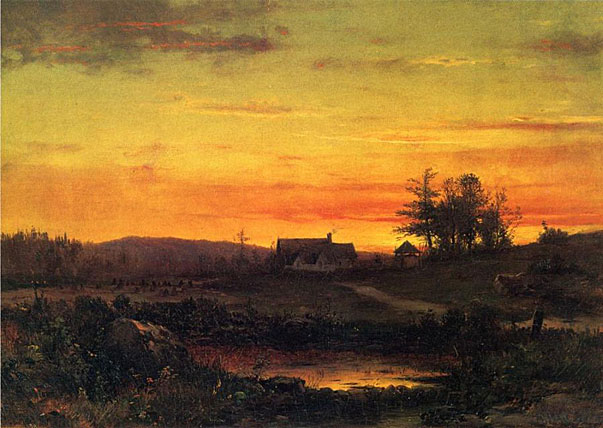
Twilight on the Marsh
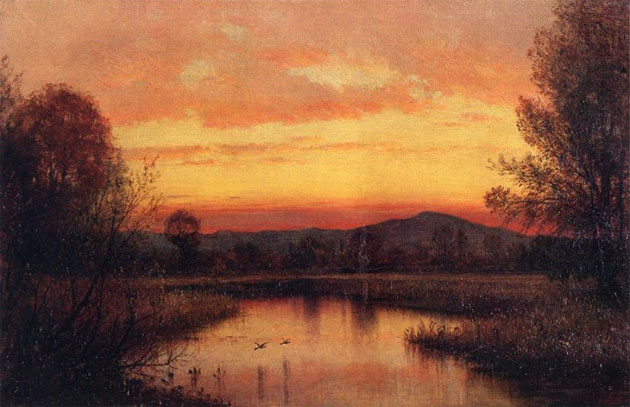
View of Kauterskill Falls: 1868
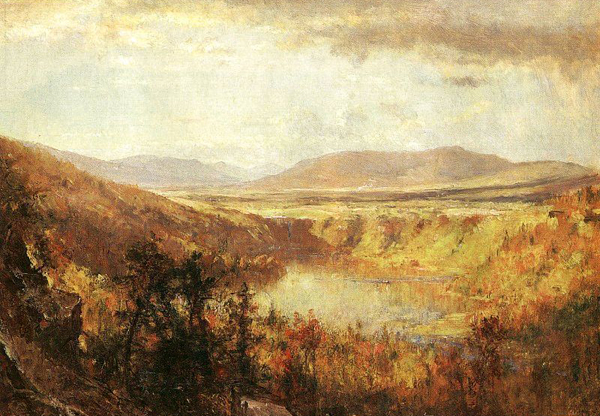
Woodland Glade
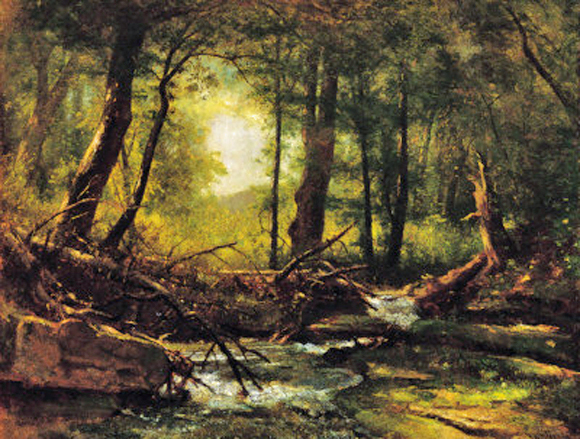
In this painting, the fallen timber evokes Nature's eternal cycle of death, rebirth, and renewal. The fallen limbs and branches are the result of natural decay, not man's intervention in the land. Whittredge departs from the panoramic scenes of the Hudson River School in this work, creating an intimate view inspired by the French Barbizon painters. The trees meet at the top like the arches of a cathedral, while the central light source suggests the illumination of a cathedral apse at the end of a nave, thus adding to the painting's reverential mood.
Woodland Interior: 1872
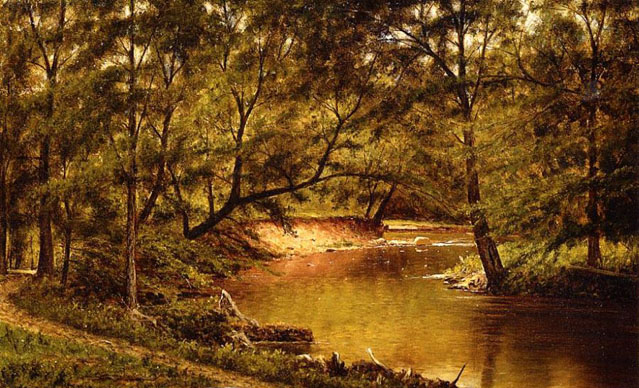
Various Paintings of Thomas Worthington Whittredge from across the American Plains and the West
A Mountain Trail, Colorado: 1868
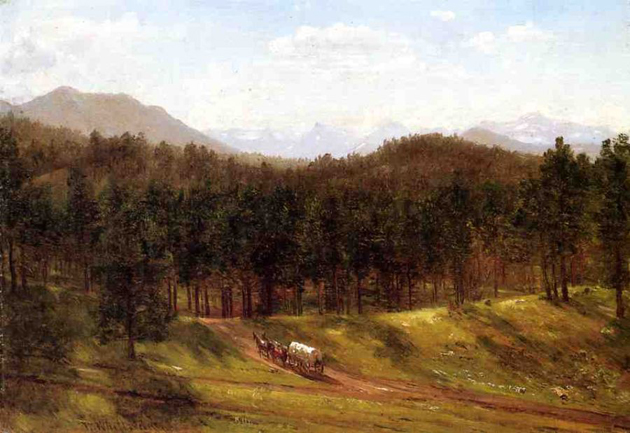
A Wagon Train on the Plains, Platte River: Date Unknown
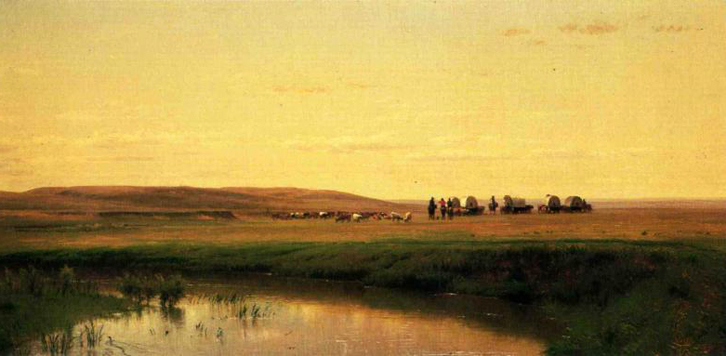
Along the Platte River, Colorado: 1867
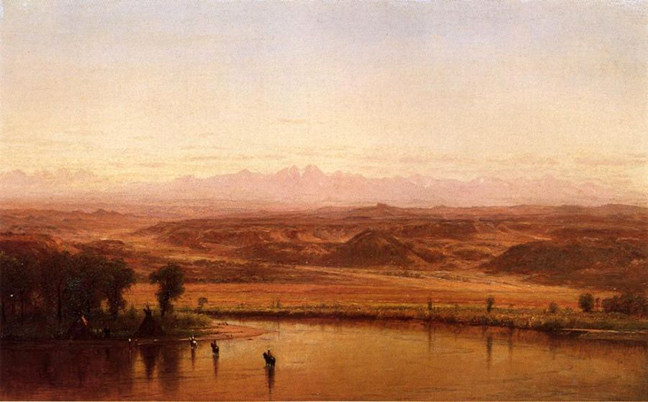
Buffalo on the Platte River: 1866
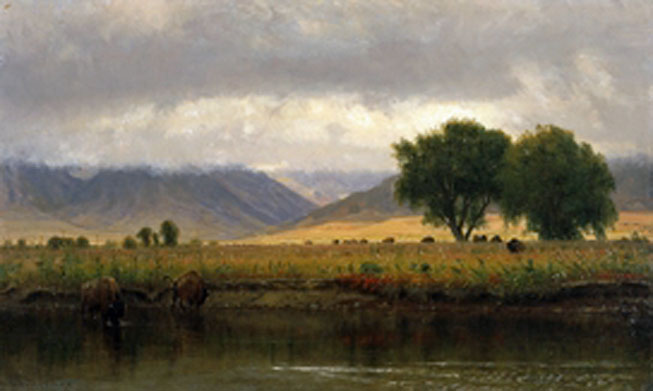
Cattle Grazing along the Platte: 1871

If some were disenchanted with the desolate plains and prairies, Worthington Whittredge, on his journey with General Pope was deeply moved by them: "I had never seen the plains or anything like them. They impressed me deeply. I cared more for them than for the mountains, and very few of my western pictures have been produced from sketches made in the mountains, but rather from those made on the plains with the mountains in the distance. Whoever crossed the plains at that period, not withstanding its herds of buffalo and flocks of antelope, its wild horses, deer and fleet rabbits, could hardly fail to be impressed with its vastness and silence and the appearance everywhere of an innocent, primitive existence." Whittredge made a total of three trips into the West but produced only about forty oil sketches and studio paintings based on Western subjects. Most were painted in his New York City studio from sketches made during his first journey to the West in 1866. The work in the Nebraska Art Collection is an on-site painting done along the South Platte River on his last trip in 1871.
Crossing the Ford: 1867
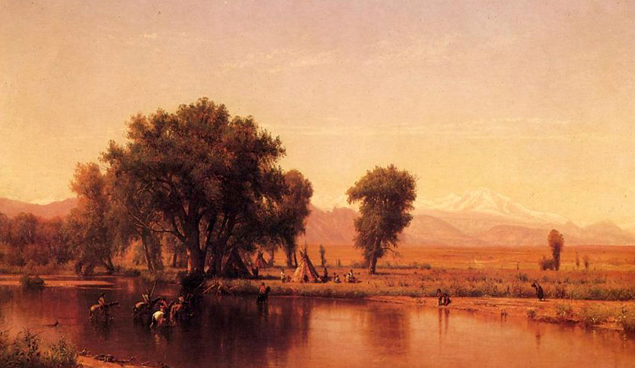
Crossing the Platte: 1870
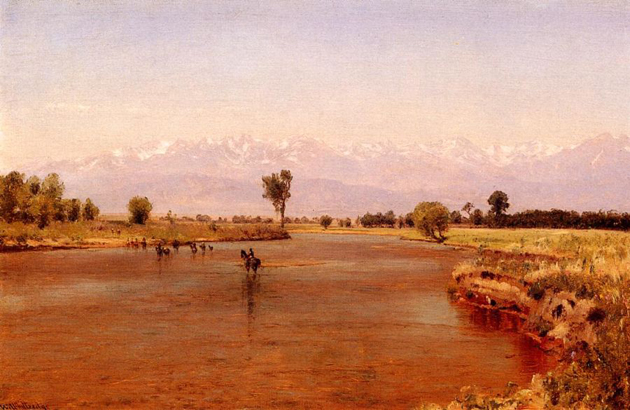
Encampment on the Platte River: 1865

From the Hartz Mountains: 1853
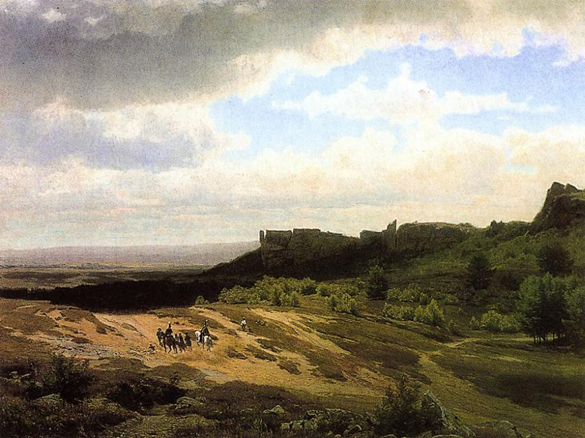
Indian Encampment on the Platte: 1870
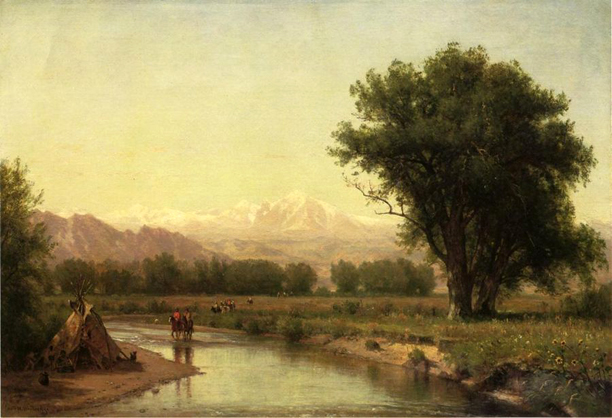
Indian Encampment on the Platte: 1870
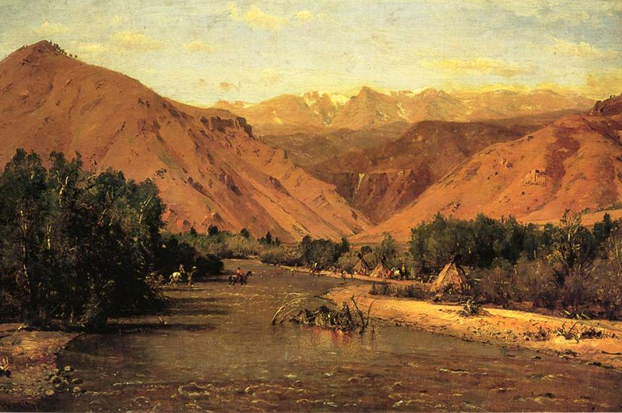
Indian Encampment on the Platte River: 1868
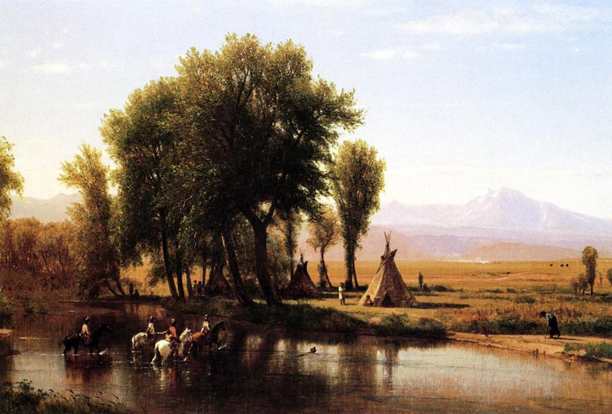
Indian Encampment on the Platte River: 1870
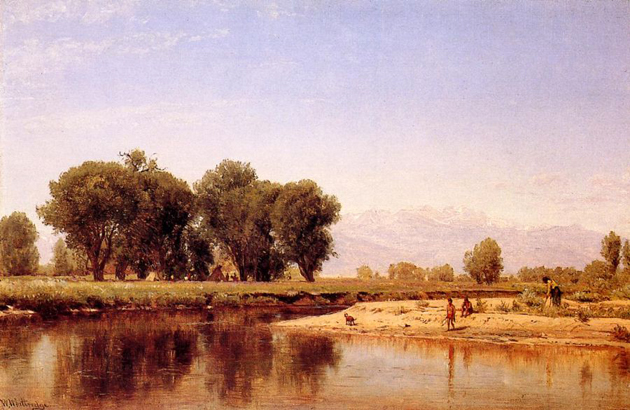
Indian Encampment on the Platte River, Colorado: 1873
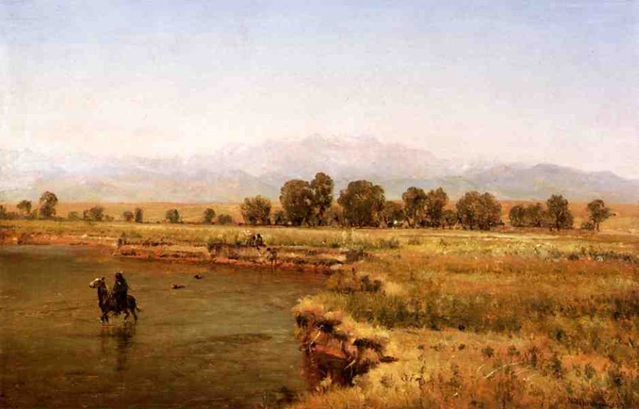
Indian Encampment
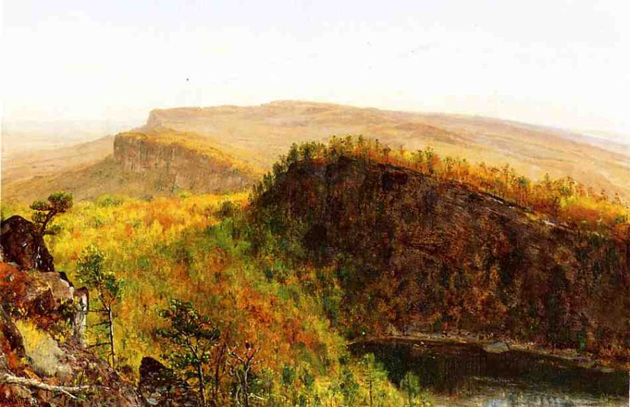
Indian Reservation: 1870
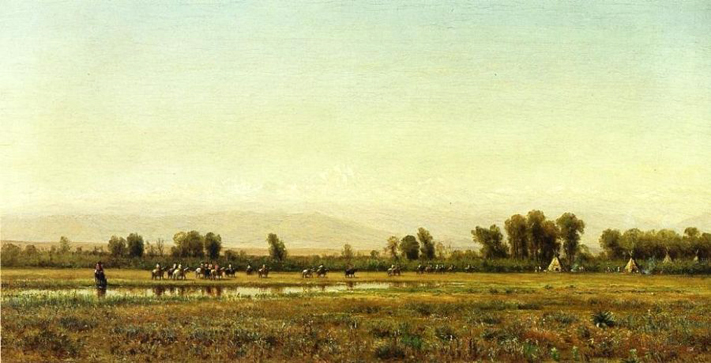
Indians Crossing the Platte River: 1867
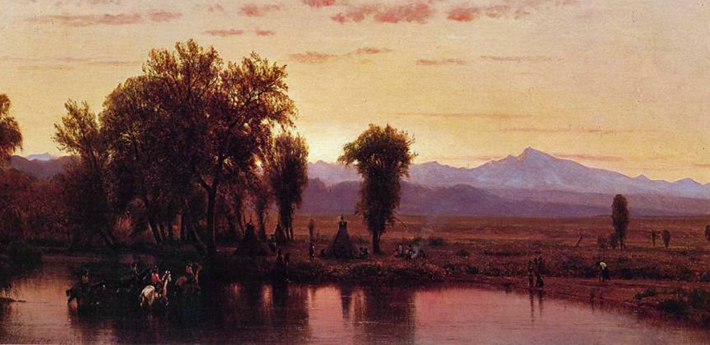
On the Cache la Poudre River, Colorado: 1871
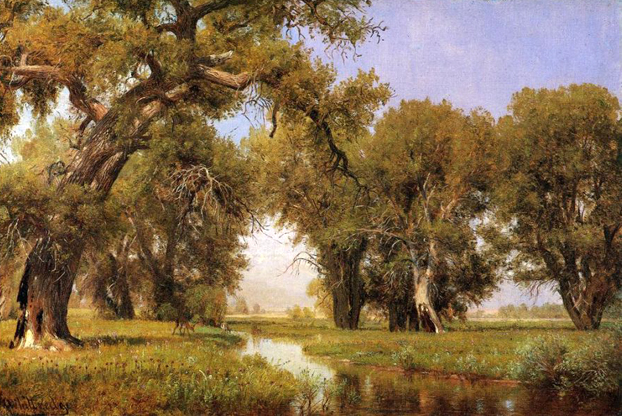
The Foothills: 1870

The Platte River
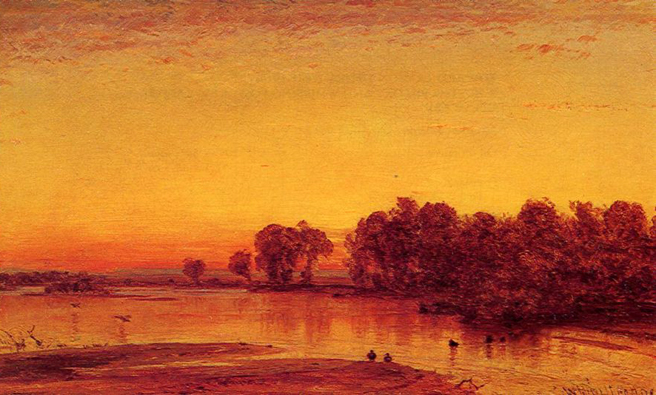
View of the Platte River: 1871

On the Platte River
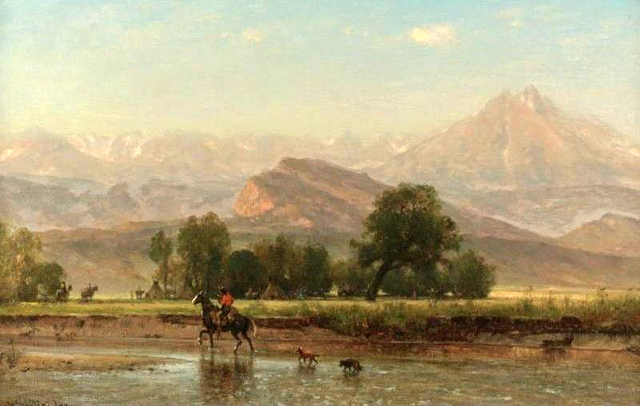
Source: Art Renewal Center
Return to Pagina Artis
Return to Bruce and Bobbie's Main Page.